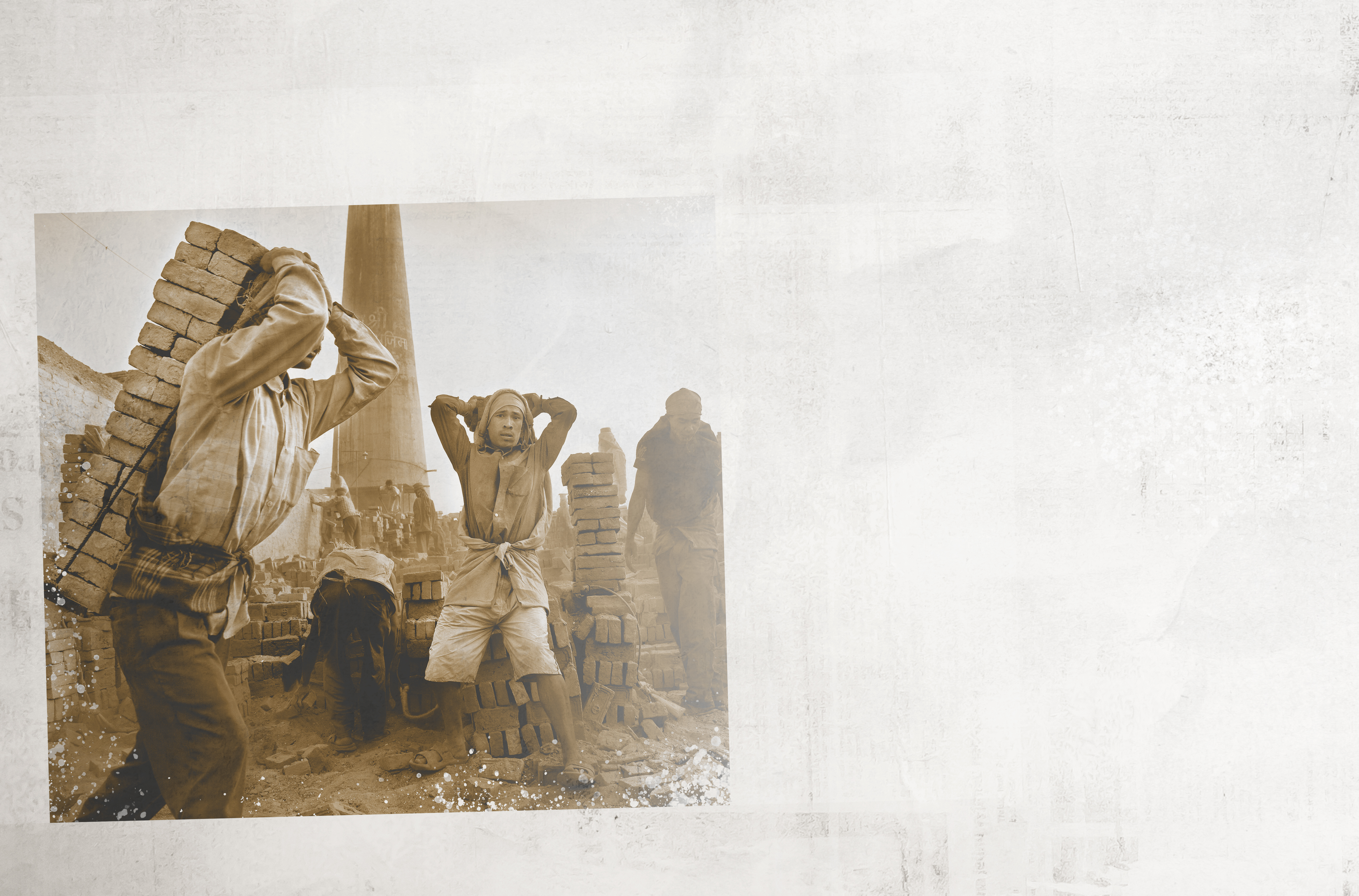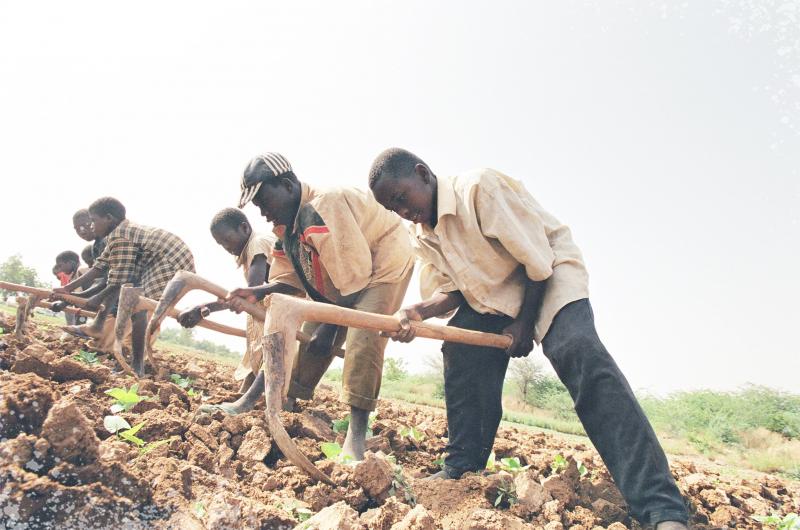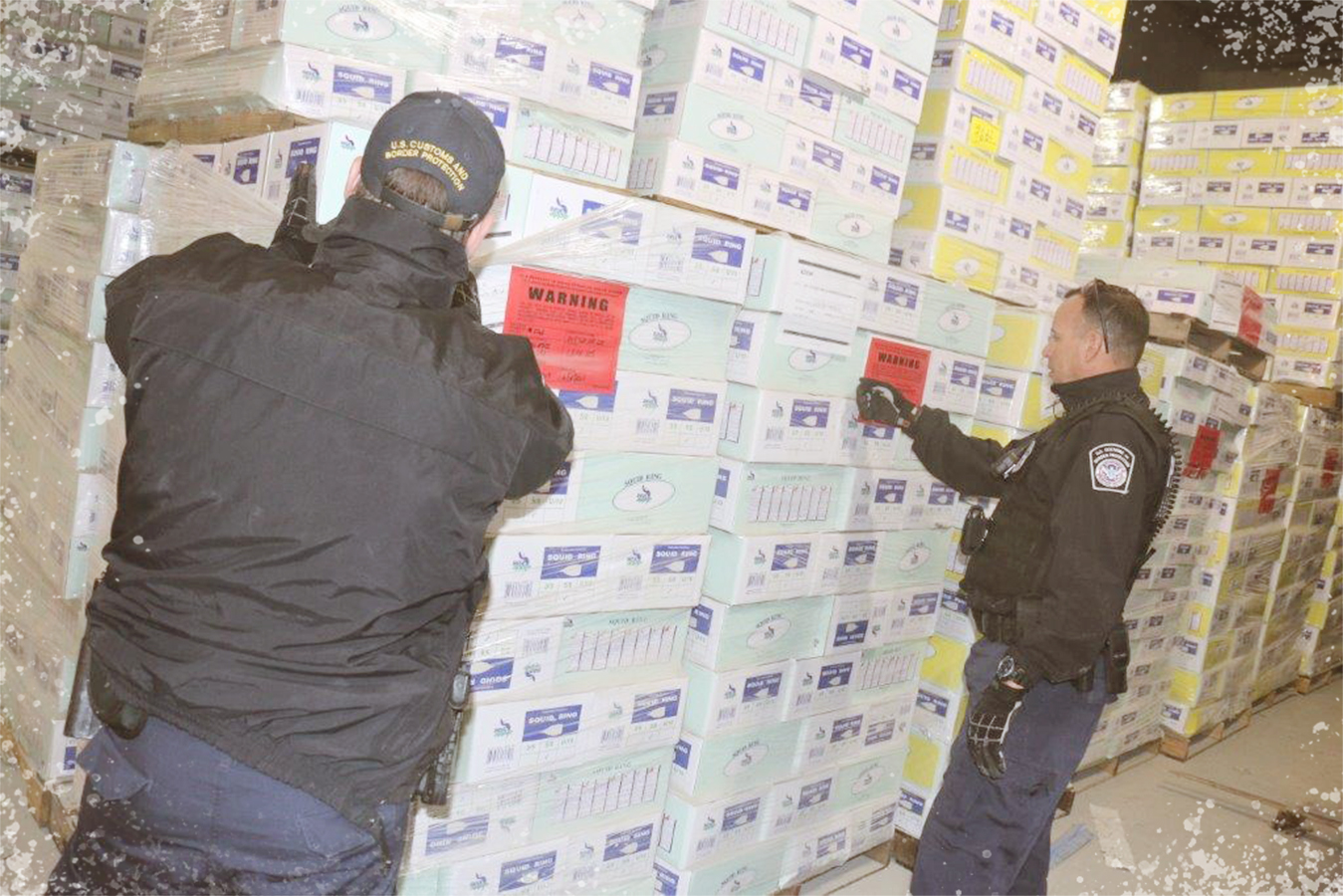
CBP Takes Aim at Forced Labor
Families work in bonded labor in a Nepal brickyard. Photo by Lisa Kristine/Human Thread Foundation
CBP’s air, land and seaports processed more than 33 million imports last year. Shirts, shoes, lumber, electronics, dishes, eggplants, squid, coffee, bricks and soccer balls are just a sliver of the commerce worth a mind-boggling $2.4 trillion, making the U.S. the world’s second largest importer behind the European Union. While trade is more robust than ever, CBP cautions importers to be watchful about the source of their merchandise.
Importers receive their commodities at the end of long supply chains that can originate anywhere in the world—in many cases regions where oversight is lax or even nonexistent. Such conditions tempt some manufacturers, miners, commercial fishermen, farmers and other producers to squeeze more profit from their businesses on the backs of laborers, some as young as 5. Lured by fraudulent promises and tantalizing offers, these workers soon find themselves trapped into toiling long hours for a pittance in harsh, many times dangerous jobs.
“There are reports of families working in mines to pay off debt that could have gone back for generations,” offered Thomas Kendrick, a supervisory international trade analyst, noting that forced labor is on the rise. Confiscating passports, withholding wages and switching work contracts are a few of the ways workers are coerced to remain obligated to the employer, according to International Labour Organization research.
Some gold mine operators in Sudan and Uganda use children to slave in toxic, hot and confined spaces, according to Department of Labor findings. Tricked by traffickers promising great jobs, they soon find themselves stuck in remote locations with no way to escape, many times held by armed guards, added Jerry Malmo, the director of the Office of International Trade’s Civil Enforcement Division.
A particularly destructive practice is artisanal mining, common not only in Africa but in parts of Central and South America, where long wooden chutes built illegally along riverbanks separate gold from gravel and sand. The operation destroys both lives and the environment, as laborers then extract more flakes of the precious metal by mixing riverbank mud and mercury with their bare hands. What remains of the toxic muck is simply tossed into the river.
“Mercury poisons land and communities and has horrible health effects,” Malmo said. “That’s horrendous.” The gold is then smuggled out of the country to be refined and sold, cutting the supply chain from the source, he added.
During a September 2017 trip along the Amazon River in Peru, Malmo witnessed the structures. “The Peruvian coast guard patrols the river. They blow them up.”
For lots of merchandise and agricultural products, tracing supply chains to suspected forced labor can be challenging. Many times the chain dead ends at a legitimate producer who buys raw material possibly moved through multiple countries to hide the supply trail. Other times, products are fabricated by several subcontractors, making it difficult for importers to know if forced labor played a role in their business. Like a river fed by tributaries upon tributaries, there’s often no single source.
Malmo pointed to the garment industry in Bangladesh. “An NGO (nongovernmental organization) tried to identify all the factories. There were several thousand. Where would they fit into the supply chain?” Each factory is likely involved in just one process of making a shirt or other apparel. One shop does the cutting, another does stitching and another sews everything together, he explained, and forced labor could be part of one or none of those operations.
While victims can be found almost anywhere—even in the United States—most of the indentured work is found in Asia, Africa and Latin America. Seventy-five countries, including China, Russia, Thailand and India, are among the nations where forced labor exists, according to the Department of Labor.
The latest estimate by the International Labour Organization reveals about 25 million people in the world are trapped in forced labor. They produce 56 different goods that enter commerce, with sugarcane, cotton, coffee and tobacco, bricks and gold being the leading products, according to Department of Labor’s List of Goods Produced by Child Labor or Forced Labor.
Glowing promises of education, marriage and jobs are also used to entice foreigners to the U.S., then traffickers trap them by exploiting their fears of being caught without proper documentation. FBI investigations have shown that most forced labor in the U.S. is found in low-skilled jobs, temporary employment or in household domestic work. Sexually oriented businesses such as strip clubs and escort services are also destinations, according to the Justice Department’s National Strategy to Combat Human Trafficking report.

The Department of Homeland Security runs the Blue Campaign, a vigorous program to combat domestic human trafficking. It educates the public on clues to detect victims and aids law enforcement with training and investigations.
The Department of Labor cites numerous atrocities.
-
Vietnam’s National Child Labor Survey estimated more than 24,000 children produce beds, chairs, tables and other furniture.
-
In Uzbekistan, the government forces at least 45,000 of its farmers and rural families to cultivate cocoons for silk. The victims are compelled to sell the product back to the government at prices potentially too low to recover their costs. Payment can be delayed or not at all. Growers are threatened with fines, loss of their land or violence for missing quotas.
-
In Indonesia, about 1,500 commercial fishing cases of forced labor were uncovered since 2015, according to the International Organization for Migration. The laborers are mostly Cambodian, Lao and Burmese nationals forced to fish as much as 22 hours a day while held in bondage for up to 10 years. While at sea, threats and physical abuse is not uncommon and the fishermen are often locked in cells to prevent escapes.
-
In the Republic of the Congo, cobalt mining by child labor is widespread. Cobalt is used by the world’s largest carmakers for the batteries that power their electric vehicles. Amnesty International said 28 of the largest companies that use cobalt, including Microsoft and Renault are not adequately tracing their supply chains.
-
In the United Kingdom, authorities recently arrested a group of traffickers who forced Vietnamese girls and women to work in nail salons, reports USA TODAY. A British charity that set up a helpline in 2016 has dealt with over 1,000 cases of modern slavery, found largely in agriculture, construction, manufacturing and car washes.
For well over a century, the U.S. has taken steps to stop these imports beginning with the 1890 McKinley Tariff Act, that banned products made by prisoners. The Smoot-Hawley Tariff Act of 1930 went a step further by prohibiting imports made by slaves and later, forced labor or children. But there was a catch: Goods made by forced labor could still be imported into the U.S. if those goods couldn’t be sufficiently provided domestically—cocoa or coffee beans, for instance.
In 2016, the Trade Facilitation and Trade Enforcement Act removed the loophole, strengthening CBP’s authority to stop suspected shipments, explained Lesleyanne Koch Kessler, deputy associate chief counsel, enforcement and operations, for CBP’s Office of Chief Counsel. CBP expects importers to have procedures in place to show their goods comply with the law. Most of that consists of good record keeping, but she suspects many importers may not be checking to see if forced labor is involved with their merchandise.
Since the act was passed, CBP has detained several commodities from China—soda ash, calcium chloride, stevia and peeled garlic.
Enforcement can be a delicate task because CBP’s stated mission is to facilitate, not hinder commerce or unfairly scrutinize an importer or manufacturer who may be the target of false claims. At the same time, enforcement protects American businesses from unfair competition.
“The stakes have never been higher as we balance border security and trade facilitation in an increasingly competitive and complex global environment,” said CBP Commissioner Kevin McAleenan at June’s U.S. Chamber of Commerce Global Supply chain Summit. “The global supply chain is changing and CBP is changing with it.”
CBP’s Office of Trade added a Forced Labor Division in November 2017 to develop enforcement cases for the Office of Field Operations. At the same time, the division reaches out to stakeholders with webinars and other tools that help importers operate within the law. In August, CBP hosted a webinar with the Department of Labor, the State Department and Verité, a non-profit worker advocacy organization, to discuss CBP’s enforcement authority and supply chain due diligence. The event drew 300 participants.
Pushing back
CBP combats forced labor mainly through tips from the public, stakeholders and other agencies since goods made by forced labor look the same as legitimate shipments. “It’s hard to determine [by inspecting], Malmo said. Ultimately, it’s up to the importer to ensure their goods comply with the law.
Anyone can report suspicious shipments to the port director or the commissioner or through the e-allegation portal at https://eallegations.cbp.gov “Parties who provide original information that leads to the recovery of any penalty, fine or forfeiture of merchandise are eligible to seek compensation,” as much as $250,000, he said.

CBP also gathers forced labor intelligence by building relationships with those close to the issue—sales representatives, lawyers, account managers and associations such as the National Fishery Institute, said Gary Melofchik, assistant center director for CBP’s Agriculture and Prepared Products Center.
An officer’s knowledge of a particular industry can also provide clues. “If someone knows it takes 50 machines to make so many garments, but an inspection shows the shop has five, then where else did this production come from?” Melofchik noted. Clues are also found in shipping documents, such as bills of lading, invoices and packing lists. “If the price is way cheaper [than reasonable] that might be forced labor. The documents must match in detail and track to the origin,” he said.
CBP also audits importers. Audits can reveal an importer’s knowledge of forced labor and the steps being taken to oversee its supply chain. For example, auditors check records and related documents, interview company officials and look for clauses in vendor contracts warning against forced labor.
Audits are as much about education as inspection. “It’s a conversation about corporate responsibility, especially if they’re doing business in a country of risk,” explained Amy Moore, assistant field director at the Atlanta Field Office, who once worked for an importer. Importers should have a comprehensive and transparent social compliance system in place to combat child and forced labor.
Importers can refer to the Organization for Economic Cooperation and Development website for numerous publications discussing supply chain management and due diligence. The Department of Labor also assists importers in setting up a social compliance system with an app for preventing child labor and labor abuses in global supply chains along with other useful information.
A comprehensive program could include a framework of principled business practices that create a corporate culture against forced labor. This effort will advance the importer’s reputation and public standing, ultimately improving business. Importers need to make big investments to keep their supply chains clean, Moore said, “It’s a cultural shift.”

CBP Office of Field Operations Seized Property Specialists Gary Dziatko (left) and Michael Morejon inspect boxes of frozen squid at a temporary storage facility in Fort Lauderdale, Florida, on April 9. The squid is suspected of being processed by forced North Korean labor and will be destroyed. Photo by Keith Smith
SPOTLIGHT ON NORTH KOREA
By Paul Koscak
Since August 2017, determining if imports were produced with North Korean forced labor became more certain. A new law requires CBP to presume that all North Korean labor is forced. The Countering America’s Adversaries Through Sanctions Act applies to goods mined, produced or manufactured by North Korean nationals or citizens.
There’s an allowance only if the importer can show the Commissioner “by clear and convincing evidence” that the goods were not made by forced labor, a tall order that places the burden of proof on the importer, said Lesleyanne Koch Kessler.
The law can be especially helpful for stopping North Korean goods coming from other countries before they reach the United States. A 2017 Associated Press report spotlighted the drab living conditions and prison-like regimentation endured by some North Korean laborers “outsourced by their government” to China and paid a fraction of their salaries.
So far, CBP officers detained 15 shipments of frozen squid arriving from China under the new statute. Of those, seven were seized; seven were denied entry and one shipment wasn’t subject to the sanction. The seized shipments, approximately 29,750 cartons weighing 297,500 pounds, will be destroyed.
An executive order signed by President Trump in September 2017 prohibits any company or person from doing business with North Korea. Sanctions from that order are meant to disable North Korea’s nuclear weapons program and missile development.


